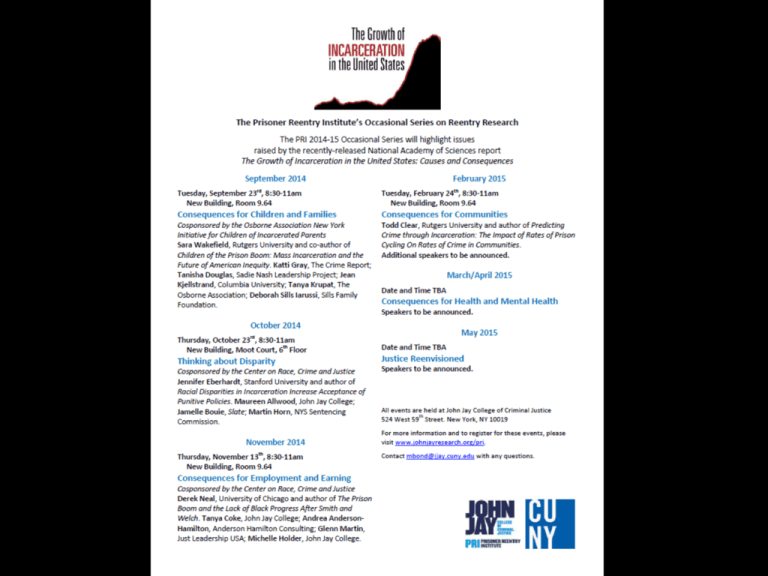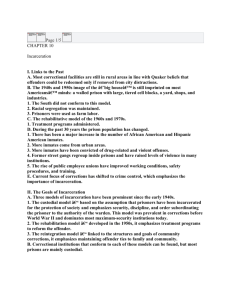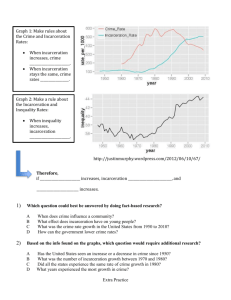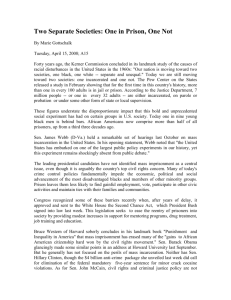Sara Wakefield's PowerPoint
advertisement

Children of the Prison Boom: Mass Incarceration and Childhood Wellbeing Sara Wakefield School of Criminal Justice Rutgers University sara.wakefield@rutgers.edu Frequent Collaborator: Chris Wildeman (Cornell) Also see the work of Kristin Turney (UC-Irvine) Annotated Bibliography of Additional Research: www.johnjayresearch.org/ pri ① Linking Mass Incarceration and Childhood Wellbeing ② Individual-Level Effects of Parental Incarceration on Children ③ Implications for Social Inequality and Long-Term Harm ④ Undoing the Damage 1. Mass Incarceration Linking Mass Incarceration and Children Historically novel, comparatively extreme. Common life experience for the urban poor. Resulting in the “systematic incarceration of whole groups.” 2005 2003 2001 1999 1997 1995 1993 1991 1989 1987 1985 1983 1981 1979 1977 1975 1973 1971 1969 1967 1965 1963 1961 1959 1957 1955 1953 1951 1949 1947 1945 1943 1941 1939 1937 1935 1933 1931 1929 1927 1925 U.S. Incarceration Rate 1925-1974 600 500 400 300 200 100 - 2005 2003 2001 1999 1997 1995 1993 1991 1989 1987 1985 1983 1981 1979 1977 1975 1973 1971 1969 1967 1965 1963 1961 1959 1957 1955 1953 1951 1949 1947 1945 1943 1941 1939 1937 1935 1933 1931 1929 1927 1925 U.S. Incarceration Rate 1925-2005 600 500 400 300 200 100 - International Comparison of Incarceration Rates HS Dropouts All Men 62.5 Black 14.7 14.8 White 4.2 22.8 Black 9 2.8 1.2 White 0 10 20 30 1970-74 40 1945-49 50 60 70 Percentage of Children with an Incarcerated Parent 12.00% 11.40% 10.10% 10.00% 8.00% 6.60% 6.00% 3.70% 4.00% 3.20% 3.50% 2.60% 2.00% 1.80% 1.30% 1.40% 0.90% 0.40% 0.00% 1980 1990 Black Source: Western & Pettit, 2009 2000 Hispanic White 2008 2. Parental Incarceration Effects Mental Health and Behavioral Problems, Homelessness, Infant Mortality, and Caregiver-Child Relationships For Fathers: Global and consequential Nearly always in the direction of harm for non-violent fathers For Mothers Variable and less consistent As often protective as harmful? Larger Implications The Concentration of Incarceration in Families Social Inequality and Race Gaps in Childhood Wellbeing Mental Health and Behavioral Problems: All children experience some of them, and they predict everything from dropout to teen pregnancy to crime Homelessness: Good insight into most marginalized children, and massive increases in black-white gaps since 1980. Infant Mortality: Considered the best measure of child health, and black-white inequalities have stubbornly held steady. Caregiver-Child Relationship: Possible important mechanism Mental Health and Behavioral Problems 7.00% 6.00% 5.00% 4.00% 3.00% 2.00% 1.00% 0.00% Internalizing Externalizing Total Aggression, Infant Mortality, and Childhood Homelessness 120% 100% 80% 60% 40% 20% 0% Aggression Infant Mortality Homelessness (Black Children) Positive and Negative Parenting Behaviors and Conflict Resolution 0.5 0.4 0.3 0.2 0.1 0 * ** Negative Conflict, NonPhysical Negative Conflict, Physical -0.1 -0.2 Emotional/Verbal Responsivity Emotional Climate Positive Parenting Behaviors Positive Conflict Resolution Negative Parenting Behaviors Physically Aggressive Behaviors by Crime Type and Abuse History Infant Mortality Summary of Individual-Level Findings Paternal incarceration increases: Behavioral problems Physically aggressive behaviors Homelessness Infant mortality Risk of conflict, abuse, and neglect by caregivers Effects usually absent in cases of a violent father or a history of domestic abuse in the family The incarceration of a non-violent father is a global harm for children 3. Aggregating Up Harms The Concentration of Incarceration in Families and Social Inequality Race Differences in the Concentration of Incarceration in Families Three or More Two One Zero 0% 10% 20% 30% Black Children 40% 50% White Children 60% 70% 80% Externalizing Problems Internalizing Problems The Contribution of Paternal Incarceration for Racial Inequality in Childhood Wellbeing 46% 25% 26% Total Behavior Problems 14% 10% 5% 0 0.05 0.1 0.15 0.2 0.25 0.3 0.35 1990 Levels of Incarceration (Vs. Zero Incarceration) 1978 Levels of Incarceration (Vs. Zero Incarceration) 0.4 0.45 0.5 The Contribution of Paternal Incarceration for Racial Inequality in Childhood Wellbeing 65% Homelessness 38% 13% Infant Mortality 7% 0 0.1 0.2 0.3 0.4 0.5 1990 Levels of Incarceration (Vs. Zero Incarceration) 1978 Levels of Incarceration (Vs. No Incarceration) 0.6 0.7 4. Undoing the Damage Summary and Unanswered Questions When we think about the forces that shape wellbeing among American children, we tend to think mostly about things like neighborhoods, schools, and families. The penal system ought to be added to the list. Interventions best found outside of the criminal justice system Enhancing social safety net Strengthening interventions in the poorest neighborhoods to reduce the damaging effects of crime and incarceration *Smart* reductions in the incarceration rate For children with currently incarcerated parents To reduce the likelihood of the experience for children at risk for parental incarceration Questions? Wakefield, Sara. 2014. “Accentuating the Positive or Eliminating the Negative? Father Incarceration and CaregiverChild Relationship Quality.” Journal of Criminal Law and Criminology 104, 4. Wakefield, Sara, and Christopher Wildeman. 2011. Mass Imprisonment and Racial Disparities in Childhood Behavioral Problems. Criminology & Public Policy 10:793-817. Wakefield, Sara and Christopher Wildeman. 2013. Children of the Prison Boom: Mass Incarceration and the Future of American Inequality. New York: Oxford University Press. Wakefield, Sara and Christopher Uggen. 2010. “Incarceration and Stratification.” Annual Review of Sociology 36: 387-406. Future Disadvantage Prior Disadvantage Incarceration







